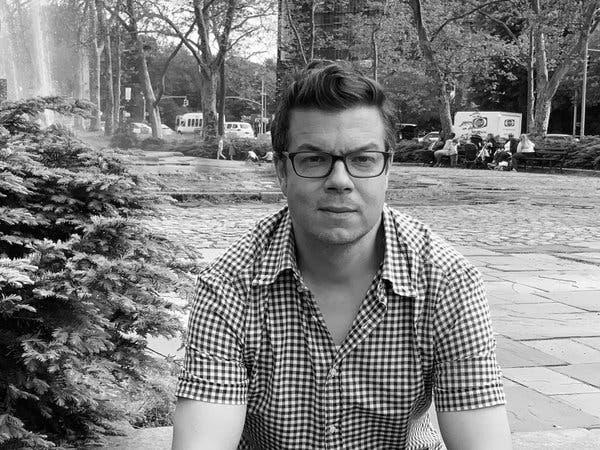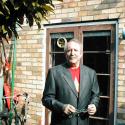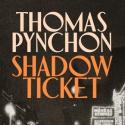The Topeka School begins with a female listener getting bored of hearing her boyfriend talk. Which did not bode well, as the perspective’s was the boyfriend, and I am a female reader. Such a self-effacing move is typically Lerneresque: he excels at agonising over the politics of the body he inhabits (a white straight American man), only to then let his agonising become bigger and baggier.
Adam and Amber are sitting in a boat in a manmade lake of an evening in Topeka, Kansas. Adam has been talking declaring their hope that they will keep seeing each other after he leaves for college. “When he turned to see what effect his speech had had, she was gone, jeans and sweater in a little pile with the pipe and lighter”. What follows is a scene of McMansion-induced horror: he moors the boat, walks into what he thinks is her house, takes a piss, only to find himself in the wrong bathroom, about to get into bed with the wrong sleeping girl.
This milieu is the “sublime of identical layouts”, where the same scene could be “taking place in kitchens all across suburbia, a vast performance of which the actors are unaware, directed by a mysterious force.” “If you opened any of the giant stainless-steel refrigerators or surveyed the faux-marble islands, you would encounter matching, modular products in slightly different configurations.” When he finds her again, she launches into an anecdote about her stepfather’s penchant for droning on, how she once slipped out from her chair and under the dinner table without him noticing. “It would take Adam twenty years to grasp the analogy between her slipping from the chair and from the boat.”
As an opening, it’s hilarious. So far, so good. The Topeka School’s predecessor, 10:04, was a book which, to quote one of its own refrains, contained multitudes. One of those multitudes was some of the best comic writing I have ever encountered before or since. But The Topeka School quickly becomes much more earnest than 10:04.
It shares one important aspect with Lerner’s debut work of fiction, Leaving the Atocha Station, in that Lerner has revisited Atocha’s protagonist, Adam Gordon, and reinstated him in Topeka. Readers may recall Adam in Madrid: getting stoned, taking prescription medication, lying, writing poems. He was a young man for whom the best that could be said was that he was acutely aware of how he was perceived as an American: that he was an underwhelming imperialising agent, spending bloated dollars all about town.
When we meet him here, Adam Gordon is a high school debate star in Topeka in 1996; it is the precise political moment in the lead-up to Senator Bob Dole’s defeat by Bill Clinton for the presidency, “a landslide victory for the Democrat that would confirm that cultural conservatism was giving, had all but given, way to the reign of more liberal baby boomers. It would confirm that history had ended.” Here too, The Topeka School shares a concern with 10:04, which also mused on Francis Fukuyama’s theory from The End of History. It was still quoted by my peers at school after the 2008 crash, and well into the early days of the Arab Spring. But they were white, monied children from south England. They thought history could not touch them.
 Fukuyama’s thesis was bluntly rebuffed in Teju Cole’s Open City, which I read alongside 10:04 in 2015, for a coursework module at university on post-war American fiction. “It is impossible, and it is arrogant, to think that the present reality of Western countries is the culminating point of human history,” Cole writes. Read alongside 10:04, it felt that some of that message had been absorbed by Lerner, instilling an anxious American self-consciousness I had never previously encountered. I loved it, and ended up writing my paper on the foetus in the American body politic, as seen in 10:04 and Revolutionary Road.
Fukuyama’s thesis was bluntly rebuffed in Teju Cole’s Open City, which I read alongside 10:04 in 2015, for a coursework module at university on post-war American fiction. “It is impossible, and it is arrogant, to think that the present reality of Western countries is the culminating point of human history,” Cole writes. Read alongside 10:04, it felt that some of that message had been absorbed by Lerner, instilling an anxious American self-consciousness I had never previously encountered. I loved it, and ended up writing my paper on the foetus in the American body politic, as seen in 10:04 and Revolutionary Road.
Richard Yates’s 1961 novel also departs from a presumed point of American arrival and eviscerates it slowly (and tragically). His protagonists are Frank and April Wheeler, an intelligent couple resentful of being stuck in suburbia. They have plans to leave it all behind, move to Paris, for April to be the breadwinner. Then she falls pregnant, which threatens to scupper their plans, and dies of a botched, self-administered abortion.
10:04’s anxieties of an arriving child are of a different nature: the protagonist (also called Ben) has been asked by his best friend to be the genetic (exact involvement tbc) father of her child. But it is always unseasonably warm in New York City, and the novel’s events take place between hurricanes Sandy and Irene, storms which swirl towards the city on satellite maps looking like octopuses or early ultrasounds. This child will be born into an erratic world of superstorms and rising seas: is it moral to summon it? Ben asks, and finds no answers, and does it anyway. Is it the right thing to be writing poems, making art, in the face of late neoliberalism and all its ills? He does it anyway.
What Revolutionary Road and 10:04 have in common, as I argued then, was a queer sensibility, in Lee Edelman’s sense. In No Future: Queer Theory and the Death Drive, Edelman offered a definition of queerness which touched on the central American anxiety about futurity; how its promise of happiness’s pursuit is only sustainable as a political claim through generational deferral. “We do it for our children, and for our children’s children,” goes the campaign cry. But why not us, in the here and now? Ask the Wheelers, asks Ben. “Fuck the social order and the Child in whose name we’re collectively terrorized,” writes Edelman, “fuck the whole network of Symbolic relations and the future that serves as its prop”. Anyone not fighting for “the children” (that vague, unsummoned mass), therefore, stands in stark opposition to the American project.
By contrast, The Topeka School has a much “straighter” subject. It’s a family affair, where the narrative baton is passed from between Adam’s parents (Jonathan and Jane) in the first person, and Adam in the third. Adam is also foiled by a classmate of his, Darren Eberheart, who has severe learning differences and who intrudes on the Gordons with italicised passages between their sections. The novel begins with Darren having thrown a cue ball at someone at a party, but we do not find out who or why until the end. In the meantime, his interludes become menacing, the italics taking on a Hitchcockian high whine, leading us towards the “Darren Eberheart incident” which an uneasy linearity. By contrast, Jane and Jonathan’s sections zigzag about in time and place, making occasional reference to Darren from various points before and after the incident. The effect is choppy, erratic; the novel lurches towards the final launching of the cue ball like a tornado swerving over open country.
Darren and Adam represent two versions of that all-American subject, the teenager, evergreen since Holden Caulfield first shuffled grumblingly onto the page. Darren, with his various impairments, is a ‘man-child’:
“He must, to fit the type, be not only male, but also white and able-bodied: the perverted form of the empire’s privileged subject. It was his similarity to the dominant that rendered him pathetic and a provocation: the man-child was almost fit for school or work or service, could almost get his license, finally discard the dirt bike; too close to the norms to prove them by his difference, the real men - who are themselves in fact perpetual boys, since America is adolescence without end - had to differentiate themselves with violence, Klaus’s voice.”
The addition of “Klaus’s voice” appears at several points in Adam’s sections. Klaus is one of the analysts at the Foundation, where Adam’s parents work as psychotherapists. He escaped the Holocaust by spending the war hidden in a chicken coop, losing his whole family to the camps (“Only we chickens survived”), going on to mentor Jonathan. Jonathan himself specialises in “lost boys”, largely white kids “who had no volkbeyond their common privilege”, and Klaus cannot take this focus seriously. “[W]hat could be more obvious than the fact they did not know what suffering was, that if they suffered from anything it was precisely this lack of suffering, a kind of neuropathy that came from too much ease, too much sugar, a kind of existential gout?” Adam ventriloquises Klaus when he wants to make intelligent pronouncements that don’t imperil his social standing as one of the real men/white kids.
The Foundation itself, we are told, was established in Topeka in 1919 as a sanatorium in the Freudian tradition. It went on to benefit from the wave of Old World analysts fleeing the Holocaust, eventually growing into a world famous centre for milieu therapy and the treatment of complex mental health conditions. As such, it tantalisingly parallels the Menninger Clinic, a sanatorium and therapy centre also begun in 1919 in Topeka. Both of Lerner’s parents were on staff (until the clinic was moved to Texas in 2003). His mother is the bestselling psychotherapist Harriet Lerner, author, most famously, of The Dance of Anger. (In the novel, her book-induced fame results in enraged men calling their house to make rape threats).
The dovetailing of these details is in keeping with the autofiction genre that Lerner has largely shaped since he published Atocha. But with the arrival of this third novel, another aspect of his work comes more firmly to light. Lerner has published three collections of poems, a monograph about poetry, and now three novels. What emerges is a repetition, across all of his work, of key phrases and images. At the end of Topeka, Adam compares the stopped Foundation clocktower to the one in the film Back to the Future, which he spends a great deal of time reflecting on in 10:04; and compares a small child making a loud noise to “an approaching storm, a large cyclonic system with a warm core”, a direct reference to one of the central images of 10:04. Another passage includes the non-sequitur :You’re a poet and you don’t even know it”, a phrase which begins The Hatred of Poetry: it is something “Mr X. used to tell us in second grade; he would utter this irritating little refrain whenever we said something that happened to rhyme.” Readers of 10:04 may also remember the long meditation on the Challenger disaster, how Reagan used the phrase “touch the face of God”, which reappears in both The Hatred of Poetry and The Topeka School. And concern with the American man-child appears in Lerner’s very first collection, The Lichtenberg Figures.
These echoes are striking, not least because they use such distinct phrases. They are not repetitive per se, but act to stitch Lerner’s oeuvre to itself, and one can’t help but feel they represent a deliberate attempt to make his work one large, multi-instalment conceptual work. They function as a heavy-handed nudge-nudge to see his utterances as linked and simultaneous, hypertext.
10:04 and Topeka can be seen as pendent pieces: when 10:04 was published in 2014, it was a thrilling and sophisticated enunciation of the late-Obama, Occupy moment; an ambitious commentary on late capitalism and neoliberalism. Lerner was celebrated for sounding his Brooklynite yawp out over the rooftops of coastal America, self-conscious about his co-op membership and his Whole Foods habit. Now in Topeka, it follows that he might turn his attention to his native Midwest, and thereby respond to Trump’s presidency.
Central to Topeka is the notion of “the spread”, a debating technique which involves dizzying your opponent, presenting them with so many arguments at speed that they have no hope of addressing each one in time. Contestants practice their enunciation but sometimes descend into glossolalia. It is not so much debate as information overload, mass distraction, the sped-up risk information at the end of ads, the fine print; it prefigures the twenty-four-hour news cycle and Twitter storms. It is an obfuscation, an anti-epistemology which prefigures Trump.
Most importantly, the spread is a form of communication breakdown. This is theme which runs insistently throughout the novel: Jonathan’s dissertation is on the collapse of speech mechanisms when speaking at speed; a man in a nursing home calls out “in a private language”; parents are “trying to make sense by vibrating columns of air”; a deserted boyfriend speaks in “nonsense rhyme”. This disintegration of meaning, we are given to understand, is what we live in now, to a degree what we have lived in at least since 1945. Jonathan recalls his childhood in Taipei in the 1950s, where his father was a low-level diplomat:
“There were cigarettes and highball or martini glasses in every adult hand. I’m not sure we kids thought of the grown-ups as smashed, but we were aware of their distance, its hysterical edge. Like those Peanuts cartoons where the adult voices are just some kind of ‘wah-wah’ noise, ... Meaningless shaped sound. [...] The collective effort of repression was tremendous, made the alcohol indispensable. An intense but contentless optimism about the future was the only protection against the recent past, in which all the regimes of value had collapsed, irradiated or gassed.”
Within this collapse is a concern, specifically, for how men communicate, as embodied in the previously mentioned duality between the hyper-verbal Adam and the cue ball-throwing Darren. Both are affected by rap, the ritualized, modular poetics of male boasting, their absorption by the privileged white kids with their existential gout. (The refrain “All eyes on me” by Tupac Shakur echoes palimpsestically, much in the manner of 50 Cent’s “many men wish death ‘pon me” in Ocean Vuong’s On Earth We’re Briefly Gorgeous.) Both boys are mocked, or run the risk of mockery. Darren’s peers compliment him on his “awesome boots”, so he cannot grasp the mockery hiding in the fact of his inclusion. Adam is a debate star and a closeted poet. “The problem for him in high school was that debate made you a nerd and poetry made you a pussy - even if both could help you get to the vaguely imagined East Coast city from which your experiences in Topeka could be recounted with great irony.” Adam is also very keen to be very good at cunnilingus (to be, as the age-old joke goes, a “cunning linguist”). Like poetry, being good at giving Amber head endangers his social standing:
“In college he would have to have to unlearn the beautiful adolescent myth that “writing” the alphabet with his tongue was a universal code for the female orgasm, but at least it expanded his range of motion. [...] To use the edge of the tongue, essential for alveolar plosives, such as /t, d/. If all he knew was to listen and respond and hold steady through the shaking, that was more than enough - combined with straight fucking - to make Amber declare him by far the greatest of her many lovers. But while he hoped she publicised this ranking, he didn’t want her divulging the centrality of oral stimulation, which would put his reputation at risk among the types. Again his tongue was both his strength and weakness.”
Please tell me if there is a greater theorisation of giving a woman head in literary fiction. Coming as it does towards the end of the novel, this is part of Adam’s deliverance from the non-verbal rage of his upbringing, from Darren and his ilk: to listen and respond and hold steady through the shaking. Do these things and you will be a great communicator; you shall be freed from the machismo which makes lost boys. It just might save us all.
- The Topeka School by Ben Lerner is published by Granta £12.99 paperback
- Read more book reviews on theartsdesk















Add comment